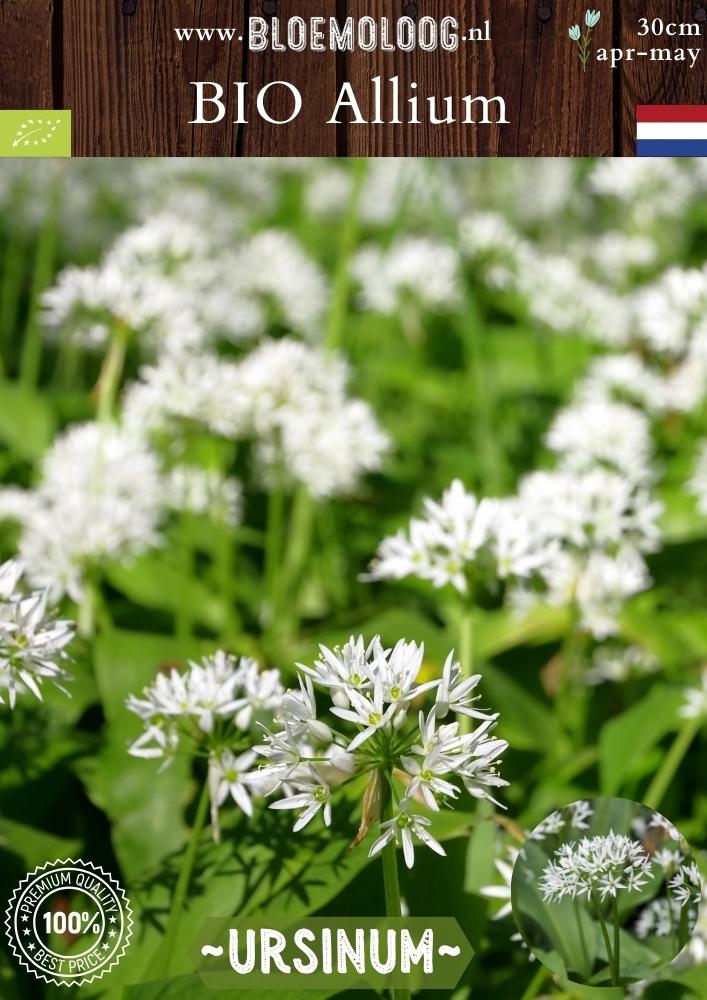Bloemoloog
Estimated Shipping Widget will be displayed here!
Couldn't load pickup availability
Organic wild garlic flower bulbs
Wild garlic (Allium ursinum), also known as ramsons, is an edible plant that belongs to the allium family (Alliaceae). The leaves of wild garlic are broad, elongated and lance-shaped. They look a bit like the leaves of lily of the valley, but give off a distinct garlic smell when crushed. Wild garlic flowers in late spring (April-May). The flowers are small, white and star-shaped, and grow in umbel-shaped clusters on thin stems. Like garlic, wild garlic forms small underground tubers, but These are considerably smaller and less pronounced than the bulbs of regular garlic.
Wild garlic can spread quickly if it is in the right place. The plant sows itself and spreads via its bulbs. This means that after a few years it can form a beautiful, natural ground cover.
Culinary use
The leaves of wild garlic are often used in cooking, especially in salads, pestos and soups. The taste is similar to that of garlic, but milder. Both the leaves, flowers and tubers can be eaten, although the leaves are used most often.
Harvesting
The leaves can be harvested from March to June, before the plant flowers. Carefully cut off some leaves without damaging the plant completely.
Medicinal
Like garlic, wild garlic is praised for its health benefits. It is said to help lower blood pressure and cholesterol levels, and has anti-inflammatory properties.
How, where and when do I plant Allium ursinum flower bulbs?
The best time to plant wild garlic is between July and October, when the plant is dormant and the bulbs (tubers) can be planted in the ground. Wild garlic thrives best in a natural, shady environment with moist, well-drained soil. Wild garlic grows naturally in woodlands, so it does well under trees, shrubs, or in places where the sun does not shine directly all day. The soil should be moist but well-drained, rich in organic matter (humus). It likes slightly acidic to neutral soil (pH 6-7). Although wild garlic can handle cold winters, it thrives better in sheltered places without strong winds.
Dig holes about 5-10 cm deep, depending on the size of the bulbs. Keep a distance of about 15 cm between the bulbs, so that the plants can spread well. Place the bulbs with the point upwards and cover them with soil.
Care
Remove the faded flowers by cutting them off at the top of the stem and let the rest of the stem and the leaves die back naturally. If you want to propagate the flower bulbs, you can dig them out of the ground in July to divide the bulbs from each other. The flower bulbs will naturalize by themselves. They can also be left in place during the summer. For the best results, give them annual organic food.
Living environment
Wild garlic grows mainly in shady, moist deciduous forests, often in large groups. It is common in Europe and parts of Asia. In the Netherlands and Belgium, wild garlic can be found in forests and parks.
Organic Allium ursinum
Skal NL-BIO-01 certified: 109459
BULK DISCOUNT C
Unfortunately sold out!
Characteristics
| Flowering time: | April - May |
| Planting time: | From September |
| Planting depth: | 7 cm deep |
| Planting distance: | 15 cm apart |
| Height: | 30 cm high |
| Flower diameter: | 10 cm wide |
| Location: | Part shade, sun |
| Soil PH: | Loam, sandy soil - Slightly alkaline/neutral |
| Winter hardiness: | Good winter hardiness |
| Propagation: | Good (naturalizes) |
| Family: | Alliaceae (Allium family) |
| Colour: | White |
| Bee friendly: | Yes |
| Fragrant: | Yes |
| Bulb size: | 4/5 |
Other allium species

NL-BIO-01
To share














